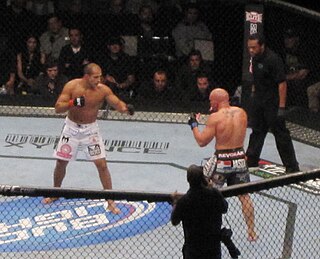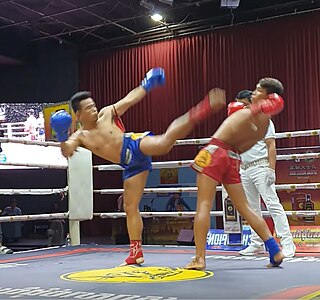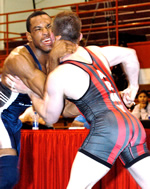
Grappling is a full-contact combat sport based on throws, trips, sweeps, clinch fighting, ground fighting and submission holds.

Kickboxing is a full-contact combat sport and a form of boxing based on punching and kicking. The fight takes place in a boxing ring, normally with boxing gloves, mouth guards, shorts, and bare feet to favor the use of kicks. Kickboxing is practiced for self-defense, general fitness, or for competition. Some styles of kickboxing include: Karate, Muay Thai, Japanese kickboxing, Sanda, and Savate.

Muay Thai, sometimes referred to as Thai boxing, is a combat sport that uses stand-up striking along with various clinching techniques. This discipline is known as the "art of eight limbs", as it is characterised by the combined use of fists, elbows, knees and shins. Muay Thai became widespread internationally in the late 20th to 21st century, when Westernised practitioners from Thailand began competing in kickboxing and mixed-rules matches as well as matches under muay Thai rules around the world. The professional league is governed by The Professional Boxing Association of Thailand (P.A.T), sanctioned by The Sports Authority of Thailand (S.A.T.).

Mixed martial arts (MMA) is a full-contact combat sport based on striking, grappling and ground fighting, incorporating techniques from various combat sports from around the world. The first documented use of the term mixed martial arts was in a review of UFC 1 by television critic Howard Rosenberg in 1993.

A strike is a directed physical attack with either a part of the human body or with an inanimate object intended to cause blunt trauma or penetrating trauma upon an opponent.

Pradal Serey or Kun Khmer is a combat sport that originated in Cambodia. The official Khmer name of the sport is Kbach Kun Pradal Khmer. The sport consists of stand up striking and clinch fighting where the objective is to knock an opponent out, force a technical knockout, or win a match by points.

In martial arts and combat sports, stand-up fighting is hand-to-hand combat between opponents in a standing position, as distinguished from ground fighting. Clinch fighting is stand-up grappling. Fighters employ striking, including striking combinations, using either body parts or mêlée weapons, to incapacitate or injure the opponent. Combatants use blocking techniques to block the opponent's attacks.

An elbow strike is a strike with the point of the elbow, the part of the forearm nearest to the elbow, or the part of the upper arm nearest to the elbow. Elbows can be thrown sideways similarly to a hook, upwards similarly to an uppercut, downwards with the point of the elbow, diagonally or in direct movement and in several other ways, like during a jump. Elbow strikes are native to the traditional Southeast Asian martial arts, traditional Chinese martial arts and traditional Okinawan martial arts.

A knee strike is a strike with the knee, either with the kneecap or the surrounding area. Kneeing is a disallowed practice in many combat sports, especially to the head of a downed opponent. Styles such as kickboxing and several mixed martial arts organizations allow kneeing depending on the positioning of the fighters. Knee strikes are native to the traditional Southeast Asian martial arts and traditional Okinawan martial arts.

Clinch fighting is the part of stand-up fighting where the combatants are grappling in a clinch, typically using clinch holds. Clinching the opponent can be used to eliminate the opponent's effective usage of some kicks, punches, and melee weapons. The clinch can also be used as a medium to switch from stand-up fighting to ground fighting by using takedowns, throws or sweeps.

In wrestling, a bear hug, also known as a bodylock, is a grappling clinch hold and stand-up grappling position where the arms are wrapped around the opponent, either around the opponent's chest, midsection, or thighs, sometimes with one or both of the opponent's arms pinned to the opponent's body. The hands are locked around the opponent and the opponent is held tightly to the chest. The bear hug is a dominant position, with great control over the opponent, and also allows an easy takedown to the back mount position.

A grappling hold, commonly referred to simply as a hold that in Japanese is referred to as katame-waza, is any specific grappling, wrestling, judo, or other martial art grip that is applied to an opponent. Grappling holds are used principally to control the opponent and to advance in points or positioning. The holds may be categorized by their function, such as clinching, pinning, or submission, while others can be classified by their anatomical effect: chokehold, headlock, joint-lock, or compression lock. Multiple categories may be appropriate for some of these holds.

An underhook is a clinch hold that is used in grappling to control the opponent. It is performed from any direction by putting an arm under the opponent's arm, and holding the opponent's midsection or upper body. Having an underhook with one arm is called a single underhook, while having underhooks with both arms is known as double underhooks. The typical response to an underhook is to try to break it, or to establish an overhook.

In wrestling, an overhook, also incorrectly called a wizard, is a clinch hold that is used to control the opponent. An overhook is performed from any direction by putting an arm over the opponent's arm, and encircling the opponent's arm or upper body. Having an overhook with one arm is called a single overhook, while having overhooks with both arms is known as double overhooks. Overhooks are typically employed in response to underhooks by an opponent.

A grappling position refers to the positioning and holds of combatants engaged in grappling. Combatants are said to be in a neutral position if neither is in a more favourable position. If one party has a clear advantage such as in the mount they are said to be in a "dominant position". Conversely, the other party is considered to be in an inferior position, usually called "on the bottom", but in this case sometimes called the "under mount".

A pinch grip tie, or an over-under bodylock, is a clinch hold and stand-up grappling position that is an extension of the over-under position, but having both hands locked behind the opponents back. The hands are typically locked with a palm-to-palm grip, palm-to-wrist grip or fingers-to-fingers grip. The pinch grip tie can be used to throw the opponent, but usually the grapplers attempt to obtain a better hold such as double underhooks or double collar tie. The pinch grip tie is often a neutral position when both grapplers symmetrically have the same hold on each other.

Over–under is a stand-up grappling position in which both combatants have one overhook and one underhook, and is the most common stand-up grappling position in mixed martial arts. The head is typically on the same side as the overhooked arm, to allow greater weight to be put on the opponent's underhooked arm, and hence preventing the opponent from using the underhooked arm effectively. The over–under position can be advanced into a pinch grip tie by locking the hands behind the opponent's back.
Yaw-Yan, also called Sayaw ng Kamatayan, is a Filipino martial art developed by Napoleon A. Fernandez and based on older Filipino martial arts. Since its inception in the 1970s, it has dominated the kickboxing scene in the Philippines and has proven very effective against other stand-up fighting arts.
Jomhod "King of the Ring" Kiatadisak is a professional Muay Thai fighter from Phang Nga province in the South of Thailand. He started learning muay Thai at the age of 7 and won his first fight when he was 11 years old. In 1986, Jomhod won the Southern Thailand Championship in 59.6 kg weight category and the same year, at the age of 16, he moved to Bangkok and began his proper fighting career.

Joseph Francis Schilling is an American professional Muay Thai kickboxer and mixed martial artist who most recently competed for Bellator Kickboxing in the Middleweight division, and in the Middleweight division for Bellator MMA. He was released from Bellator in October 2020 after the Mohegan Tribe Department of Athletic Regulations refused to grant him a license to fight.
















